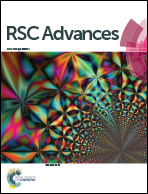Sonophysical cost effective rapid indigenous preparation of aluminium particles via exfoliation of aluminium foil
Abstract
A rapid sonophysically aided process of obtaining aluminium particles from commercial aluminium foil has been attempted for the first time. Through the cavitation-enabled exfoliation of the foil, particles were obtained following seiving in size ranges of >125 μm, 25–50 μm and <25 μm. The prepared particles were tested for their bacterial compatibility/toxicity against Escherichia coli and Streptococcus mutans. Reports on the effect of aluminium on bacterial cells are highly limited and no data exists on the influence of aluminium particles and its bacterial interactions. Moreover, no data on the size-dependent bactericidal activity of aluminium is available either. This work fills in these voids and confirms that size-dependent toxicity of Al particles exists below 25 μm.


 Please wait while we load your content...
Please wait while we load your content...